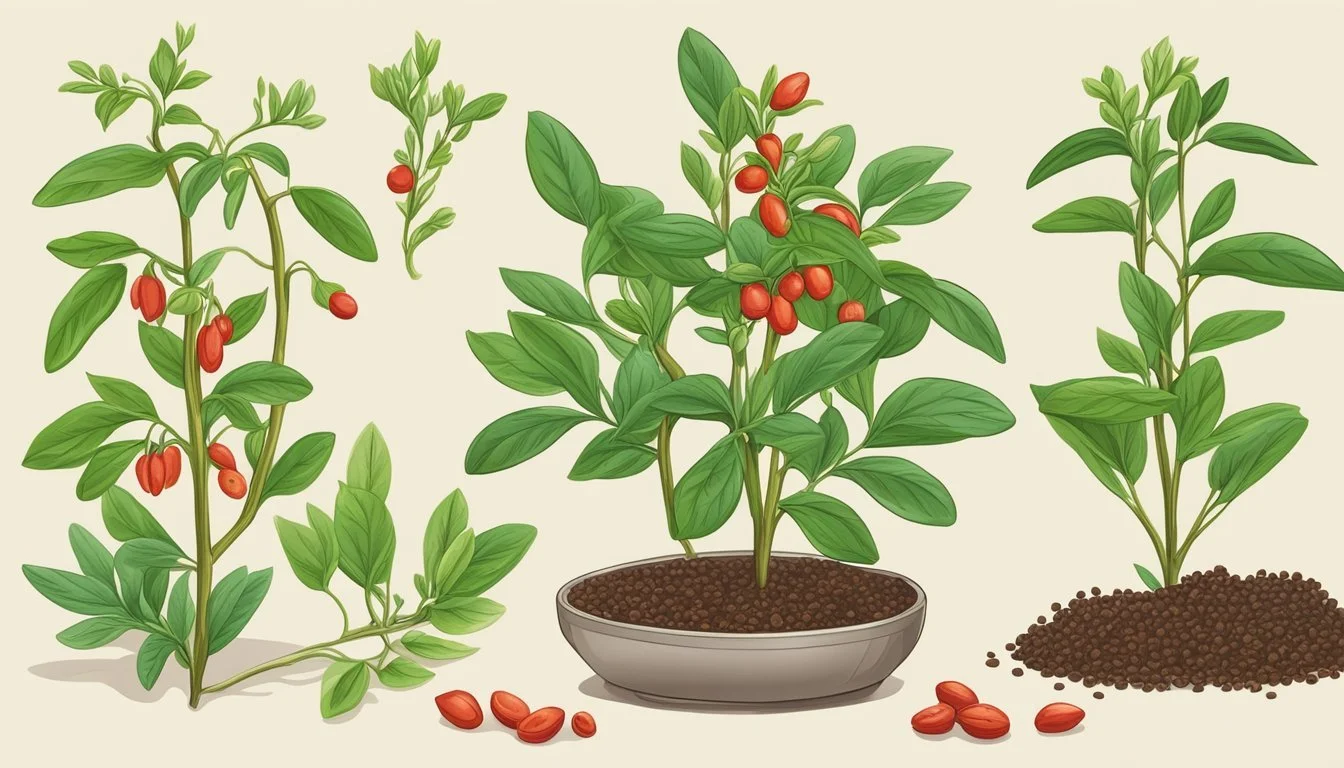How Long Do Goji Berries Last?
Shelf Life and Storage Tips
Goji berries, also known as wolfberries, have gained popularity in Western markets due to their high nutrient content and potential health benefits. These small, red fruits can be found in various forms, but dried goji berries are common for their convenience and extended shelf life. Understanding the longevity of dried goji berries is crucial for consumers looking to maintain quality and get the most out of their purchase.
In optimal storage conditions—specifically a cool, dry, and dark place—dried goji berries can last from four months to one year. Once the package is opened, transferring the berries to sealed jars or airtight containers can help preserve their quality. If stored in a pantry or a refrigerator, goji berries can retain their taste and nutritional value for the duration of their shelf life. Ensuring the goji berries remain dry and are kept away from direct sunlight and heat sources is essential to prevent spoilage.
Origins and Cultural Significance
Goji berries, often heralded as a superfood, have deep roots in Asian culture and history, particularly within China. They are not only valued for their nutritional benefits but also for their significance in traditional healing practices.
Historical Context
Goji berries, or Lycium barbarum and Lycium chinense, are native to Asia, predominantly grown in the northwest province of Ningxia in China. Historical records suggest that these berries have been harvested for over 4,000 years. The indigenous people of these regions have long revered goji berries, which are also known as wolfberries, for their life-sustaining nutrients and their resilience in harsh climates.
Traditional Uses
In traditional Chinese medicine, goji berries have been used for centuries. They are believed to support liver and kidney health and are said to improve vision. Their use in Asia, particularly China, spans a myriad of health-related applications from brewing in teas to including them in medicinal concoctions. The berries are often included in a variety of culinary dishes, as they are considered to bolster health and longevity.
Nutritional Profile
Goji berries are nutrient-dense fruits known for their high concentration of vitamins, minerals, and antioxidants, offering various health benefits.
Constituents
Goji berries are a rich source of nutrients that include:
Carbohydrates: They account for about 46% of the fruit's composition, primarily from natural sugars and dietary fiber.
Protein: Goji berries contain approximately 13% protein.
Fiber: With about 16.5% dietary fiber, these berries aid in digestive health.
Vitamins: They are exceptionally high in Vitamin A, providing up to 250% of the daily value, and have a significant Vitamin C content.
Minerals: Goji berries offer minerals such as iron (about 11% DV) and contain trace amounts of selenium.
Health Benefits
Consuming goji berries can have several positive health effects:
Antioxidants: The berries contain antioxidants that help protect the body against free radicals.
Immune System: High in Vitamin C, goji berries support the immune system.
Eye Health: The high levels of antioxidants, including zeaxanthin, contribute to eye health and may slow the progression of macular degeneration.
Diabetes and Weight Loss: Being low in fat and high in fiber, goji berries can be a beneficial addition to the diets of those managing diabetes or pursuing weight loss.
Buying and Storing Goji Berries
When purchasing goji berries, their potential shelf life is significantly influenced by their initial quality and subsequent storage conditions. There are specific practices to follow for both fresh and dried varieties to ensure maximum freshness.
Selection Criteria
For fresh goji berries, one should look for plumpness and a vibrant red-orange color, indicative of good quality. Any signs of mold, mushiness, or discoloration are markers for rejection. In the case of dried goji berries, they should resemble bright orange-red raisins. Before storage, it's crucial to inspect both fresh and dried goji berries, discarding any that are damaged.
Optimal Storage Conditions
To optimally store fresh goji berries:
They should be refrigerated in a moisture-controlled environment.
A temperature range of 0-4°C (32-39°F) is ideal.
Before refrigerating, berries should be gently washed and dried.
For dried goji berries:
Keep in a cool, dry, and dark place, such as a pantry.
An airtight container is essential to prevent humidity from softening them.
Typical shelf life ranges from 4 months to 1 year.
As temperature and exposure to light and moisture can degrade goji berries, maintaining controlled conditions is crucial for preserving their shelf life.
Preservation Methods
Preserving goji berries correctly is essential to maintain their nutritional value and flavor. Two effective methods are the drying process and freezing technique, both of which significantly extend the shelf life and usability of these berries.
Drying Process
Dried goji berries are a common form of preservation that involves removing moisture, which helps in preventing spoilage. This can be achieved by using either a dehydrator or an oven.
Dehydrator: Set at a low temperature, a dehydrator can evenly dry goji berries over several hours. Here's a simple guide:
Place goji berries in a single layer on the dehydrator tray.
Dry at 115°F (46°C) until they are chewy and no visible moisture remains.
Oven: For those without a dehydrator, an oven set to a low temperature can be used.
Preheat the oven to the lowest possible temperature (usually between 135°F and 145°F, or 57°C to 63°C).
Spread goji berries on a baking sheet in a single layer.
Leave the oven door slightly ajar to allow moisture to escape and check periodically to prevent burning.
It's crucial that goji berries are completely dry before storage to avoid the growth of mold due to residual moisture.
Freezing Technique
Freezing goji berries can help in preserving their freshness and extending their shelf life for months. Goji berries should be frozen in a way that minimizes exposure to humidity and freeze burn.
Preparation for Freezing:
Wash and dry the goji berries completely.
Spread them out on a baking sheet in a single layer to freeze them individually.
Once frozen, transfer the berries to an airtight, freezer-safe container or bag.
Freezer Storage:
Place the sealed container or bag in the coldest part of the freezer.
Keeping goji berries at a consistent temperature of 0°F (-18°C) will ensure they remain safe to consume for an extended period.
By following these preservation methods, goji berries can be stored effectively while retaining their desirable qualities.
Consumption and Usage
When considering the consumption and usage of goji berries, one should be aware of their versatility in culinary applications and the importance of adherence to recommended servings. These aspects are crucial in maximizing their nutritional benefits as a superfood.
Culinary Applications
Goji berries have a distinct flavor profile that lends itself well to various culinary applications. They can be consumed dry, similar to raisins, or rehydrated for softer texture. Here are specific ways they can be incorporated:
Tea: Steeping dried goji berries in hot water creates a nutrient-rich tea.
Juice: Incorporating goji berries into juices adds a sweet and tangy taste.
Smoothies: For a nutrition boost, goji berries blend well into smoothies.
Cereal: Adding dried goji berries to cereal increases its nutritional value.
Trail Mix: Goji berries make for a colorful and healthy addition to trail mixes.
In terms of cooking, they can enhance the flavor and nutrition in dishes.
Recommended Servings
Moderation is key when consuming goji berries due to their potent nutritional profile. The general guideline for serving size is as follows:
Dried Goji Berries: 1-2 tablespoons per day.
Goji Juice: Approximately 4 ounces (120 ml) per serving.
Individuals should consider their overall diet and consult with a healthcare provider to determine the appropriate serving size for their needs. Consumption should be balanced to avoid any adverse effects.
Appearance and Texture Attributes
When assessing the longevity of goji berries, one should consider specific characteristics related to their appearance and texture. These factors are critical in determining whether the berries are in a suitable state for consumption.
Color and Form
Dried goji berries typically exhibit a bright orange-red hue, similar in size to that of raisins. As they age or if they are of poor quality, goji berries may lose this vibrant color, turning a darker shade that signals a decline in freshness. For fresh goji berries, one should look for a vivid red color and a plump form, as these are indicators of ripeness and good quality.
Ripe, dried goji berries: Bright orange-red color
Overaged or bad quality: Dark, dull color
Freshness Indicators
The texture of goji berries offers insight into their freshness. When fresh, they should be soft but not overly squishy, with a certain chewiness akin to that of plump raisins. Dried goji berries that have turned hard, or conversely, are too sticky, likely indicate that they are no longer fresh.
Fresh goji berries: Soft to the touch, chewy texture
Stale goji berries: Hardened or overly sticky texture
The assessment of these attributes is key in determining not only the current state of the goji berries but also in predicting their remaining shelf-life.
Potential Health Considerations
When incorporating goji berries into a diet, it is vital to be aware of their known side effects and possible interactions with medications. The consumption of goji berries may offer health benefits, but they must be approached with caution for those with certain medical conditions or those taking specific medicines.
Known Side Effects
Goji berries are generally safe for most people when consumed in moderate amounts. However, they have been associated with several side effects, particularly when consumed in large quantities. Some reported adverse effects include:
Allergic reactions: Rare but possible, and may include hives, itching, or swelling.
Digestive discomfort: Overconsumption can lead to gastrointestinal issues such as nausea or diarrhea.
Interactions with Medications
Goji berries may interact with specific medications, and individuals on these medicines should consult a healthcare provider before adding goji berries to their diet. Significant interactions include:
Blood thinners (such as warfarin): Goji berries might interact with warfarin, potentially affecting the medication's effectiveness and increasing the risk of bleeding.
Diabetes medications: Since goji berries can affect blood sugar levels, there may be an interaction with diabetes drugs, requiring adjustments to dosages.
Blood pressure drugs: There is a potential for goji berries to lower blood pressure, leading to an additive effect when taken with antihypertensive medications.
Incorporation Into Diets
Incorporating goji berries into diets is a straightforward method to benefit from their high nutritional content. They are compatible with a variety of dietary preferences and can be creatively integrated into multiple types of meals.
Dietary Compatibility
Goji berries are often termed as a superfood due to their substantial nutritional profile which includes protein, fiber, and a variety of vitamins and minerals. They are a versatile ingredient that can complement different diets, from vegan to gluten-free. For those who monitor their dietary intake, goji berries offer a low-calorie option that is dense in nutrients.
Examples of Goji Berry-Inclusive Diets:
Vegan/Vegetarian: An excellent plant-based source of protein.
Gluten-Free: Naturally gluten-free, they are safe to include.
Low-Calorie: Beneficial for weight management diets.
Creative Integrations
Goji berries' slightly tart flavor makes them a dynamic addition to many recipes. They can easily be incorporated into the morning routine by adding them to cereal, yogurt, or smoothies.
Ideas for Goji Berry Integrations:
Snack Options: Add dried goji berries to a trail mix.
Breakfast Ideas: Sprinkle on top of cereals or blend into smoothies.
For baking, goji berries can be a unique, nutritious ingredient. When used in cookies or muffins, they not only infuse the dish with their distinctive flavor but also boost the fiber content.
Meal Type Way to Integrate Goji Berries Breakfast Blend in smoothies; top on yogurt or cereal. Baked Goods Mix into cookie dough or muffin batters.
Lifecycle of Goji Berries
Goji berries, originating from China, follow a distinctive growth cycle starting from a seed to a fruit-bearing shrub. Understanding their growth and harvesting phases is crucial for optimal yield and quality.
Growth
The seed of the goji berry begins its journey to become a fruiting shrub in well-drained soil. They thrive particularly well in full sunlight but can tolerate partial shade. The goji berry plant is adaptable to various soil types, yet it prefers a more alkaline environment. During the growing season, the plant requires regular watering to establish its root system but is otherwise drought-tolerant once mature. The goji berry shrub can reach a height of up to 5 feet and as wide, spreading its branches outwards with lush green foliage.
Harvesting
When fall arrives, goji berry shrubs enter their harvesting season. The berries should be harvested carefully by hand to avoid damage, as they are delicate when ripe. The ideal time for harvest is when the berries have achieved a vibrant orange-red hue and are plump. This period is crucial for farmers in China and around the world, as proper timing ensures the highest quality of goji berries, which are revered for their nutritional benefits. After being plucked from the shrub, they are either consumed fresh, dried for longer shelf life, or processed for various goji-based products.










